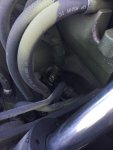FYI. My 1300L chassis "designed from scratch" for the German military in the eighties (20 years after the SEE chassis fuel system was designed) which initially had a similar OM352 engine, gravity fuel system and produced during the same era doesn't have the strainer (unless I haven't found it yet). It does have a disposable clear plastic inline strainer with a visible fuel element downstream of the fuel pump on the injector. Since its on the downstream side of the fuel pump I expect there isn't any worries about leaky O rings but if the tank is full of crap it may make it to the fuel pump. I expect it has a strainer sock in the tank (but haven't looked). My 1300L sat in storage for some unknown period of time and it too had some crap in the tank which the filter catches. I expect someone could get rid of the stock strainer on the suction side of the fuel pump and put an inline filter on the downstream. That gets rid of the potential for air leaks at the strainer (although the flexible hoses on top of the tank would remain).
As I've learned (usually the hard way) more about the FLU's fuel system - up to but not including the injector pump - I've largely changed my mind about it.
At first it was "Let's rip this crap out and replace it all, using rubber hose and...". These days I think it's a well functioning setup. Not perfect, but certainly fully functional.
Replacing the plastic hose, as needed, is cheap and easy. Replacing the washers at the banjos is, too. Eliminating the leak at the strainer cup was only a matter of finding the correct size O-ring.
Now I can't really remember the last time I had to prime a FLU. I've even stopped putting fuel in the strainer cup after cleaning it out.
I still like to take a look in the strainer on occasion, to see if there's any crap or water in it. Basic preventive maintenance, really.
It'd be nice to have a clear hose entering the fuel filters, so any air leaks could be spotted with relative ease. And I call it relative since the hood still has to be slid to the left to see it.
Now, without age-induced air leaks the stock setup seems to works fine - until there is bacteria, fungus, water, or lots of rust in the tank. Again, I don't blame Mercedes for that part. It's up to us to get rid of whatever crap is in the tank, regardless of how it ended up in there, and then keep the system clean.







